埃及家族性地中海热儿童的代谢综合征:病例对照研究
IF 0.5
Q4 PEDIATRICS
引用次数: 0
摘要
家族性地中海热(FMF)是全球发病率最高的遗传性自身炎症性疾病。代谢综合征(MetS)是一组相互关联的风险因素;胰岛素抵抗、肥胖、血脂异常和高血压是代谢综合征的主要组成部分。本研究旨在调查埃及 FMF 患儿在无发作期代谢综合征的组成因素。这是一项病例对照研究,在开罗大学医学院儿童医院小儿风湿病门诊和小儿内分泌门诊进行。研究对象为 40 名 FMF 患者。这些患者男女均有,年龄均在 10 岁或以上,处于无 FMF 发作期;他们与 40 名年龄和性别明显匹配的健康儿童作为对照组进行了比较。这项研究中的所有受试者都接受了详细的病史采集、人体测量、全身和系统检查。实验室评估(研究时)在研究时进行,包括全血细胞计数和差值、尿素氮、肌酐、血沉、血清淀粉样蛋白 A、尿液分析、血清胰岛素、空腹血糖和血脂分析。从患者档案中收集了 FMF 基因突变情况。FMF患者的平均(±SD)年龄为12.65±1.82(10-17)岁,对照组的平均(±SD)年龄为12.6±1.82(10-16)岁。在 FMF 患者中,50% 为男性,50% 为女性(F:M = 1:1),而在对照组中,47.5% 为女性,52.5% 为男性。所有 FMF 患者都处于无发作期。两组患者在胰岛素抵抗方面的差异有统计学意义,FMF 患者的胰岛素抵抗更为常见,P 值为 0.025。我们的 FMF 患者都不符合代谢综合征的定义标准,但病例和对照组在胰岛素抵抗方面存在显著差异,FMF 患者的胰岛素抵抗发生率更高,这可能是由于亚临床炎症的持续存在。这表明,患有 FMF 的儿童日后患代谢综合征的风险可能更高。本文章由计算机程序翻译,如有差异,请以英文原文为准。
Metabolic syndrome among Egyptian children with Familial Mediterranean Fever: a case–control study
Familial Mediterranean fever (FMF) is the most prevalent inherited autoinflammatory disease globally. Metabolic syndrome (MetS) is a cluster of interrelated risk factors; insulin resistance, obesity, dyslipidemia, and hypertension are the main constituents of MetS. This study aimed to investigate components of metabolic syndrome among Egyptian children with FMF during the attack-free period. This is a case–control study that was conducted in the Pediatric Rheumatology Outpatient Clinic and Pediatric Endocrinology Clinic, Children’s Hospital, Faculty of Medicine, Cairo University. It was conducted on 40 patients with FMF. The patients included were of both sexes and aged 10 years or older, during the FMF attack-free period; they were compared to 40 apparently healthy age- and sex-matched children as controls. All subjects in this study were subjected to detailed history taking, anthropometric measurements, general and systemic examinations. Laboratory evaluation (at the time of the study) was done at time of study, in the form of CBC with differential, BUN, creatinine, ESR, serum amyloid A, urine analysis, serum insulin, fasting blood glucose, and lipid profile. FMF gene mutations were collected from patients’ files. The mean ± SD age of FMF patients was 12.65 ± 1.82 (10–17) years, while the mean ± SD age of the control group was 12.6 ± 1.82 (10–16) years. Among FMF patients, 50% were males, and 50% were females (F:M = 1:1), while in the control group, 47.5% were females, and 52.5% were males. All FMF patients were during the attack-free period. There was a statistically significant difference between both groups regarding insulin resistance, being more frequent among the FMF patients’ group, with a p-value of 0.025. None of our FMF patients met the criteria for the definition of metabolic syndrome, but there was a significant difference between cases and control regarding insulin resistance with higher frequency among FMF patients, probably due to the ongoing subclinical inflammation. This indicates that children with FMF may be at a higher risk of getting metabolic syndrome later on in life.
求助全文
通过发布文献求助,成功后即可免费获取论文全文。
去求助
来源期刊

Egyptian Pediatric Association Gazette
PEDIATRICS-
自引率
0.00%
发文量
32
审稿时长
9 weeks
期刊介绍:
The Gazette is the official journal of the Egyptian Pediatric Association. The main purpose of the Gazette is to provide a place for the publication of high-quality papers documenting recent advances and new developments in both pediatrics and pediatric surgery in clinical and experimental settings. An equally important purpose of the Gazette is to publish local and regional issues related to children and child care. The Gazette welcomes original papers, review articles, case reports and short communications as well as short technical reports. Papers submitted to the Gazette are peer-reviewed by a large review board. The Gazette also offers CME quizzes, credits for which can be claimed from either the EPA website or the EPA headquarters. Fields of interest: all aspects of pediatrics, pediatric surgery, child health and child care. The Gazette complies with the Uniform Requirements for Manuscripts submitted to biomedical journals as recommended by the International Committee of Medical Journal Editors (ICMJE).
 求助内容:
求助内容: 应助结果提醒方式:
应助结果提醒方式:


